South American Solstice Sojourn, chapter 2
Brasil: The promised land across the river
It has been a whirlwind over the last weeks, so I have only found a chance to continue this travelog here in the airport in Buenos Aires, awaiting my flight back to Florida. When I land, I hope to be greeted by the local news that one poseur in the republican party - Rudy Guiliani - will be no more a contender for the presidency of our screwed up republic.
But on to the matters at hand...
I spent the day today walking around the Buenos Aires neighborhood of San Telmo. Lovely place, where the cobblestone streets add to the colonial charm. As I wandered, I couldn't help thinking about the contrast with Asunción, where stone streets are not there for their attractiveness, but for their longevity and economy. This, in combination with the shock-less buses, make for ass-crushing bus rides through town on most of the local routes. When the buses finally hit a paved road, it is something to be thankful for.
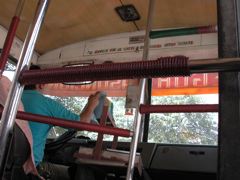 The drivers are quite a sight to behold. This ain't Seattle, where bus drivers wait patiently until all passengers have paid and at least grab a hand-hold before proceeding. Not only do the Asunción drivers take your fare and make change for you while en route (the drivers must have been seriously pissed when they raised the fares from 2000 Guaraní to 2200 recently), but they generally don't even wait for you to get on the bus before starting on their way. Also, note that these buses all have manual transmissions, so they are changing gears, counting and passing change, tearing off the generally superfluous tickets and turning the wheel, all simultaneously. Quite a juggling act. Disembarking, too, requires good passenger timing, since the bus never really seems to come to a complete stop. They do slow down for you, though. Usually.
The drivers are quite a sight to behold. This ain't Seattle, where bus drivers wait patiently until all passengers have paid and at least grab a hand-hold before proceeding. Not only do the Asunción drivers take your fare and make change for you while en route (the drivers must have been seriously pissed when they raised the fares from 2000 Guaraní to 2200 recently), but they generally don't even wait for you to get on the bus before starting on their way. Also, note that these buses all have manual transmissions, so they are changing gears, counting and passing change, tearing off the generally superfluous tickets and turning the wheel, all simultaneously. Quite a juggling act. Disembarking, too, requires good passenger timing, since the bus never really seems to come to a complete stop. They do slow down for you, though. Usually.
Just after New Years, Bee & I took a two week trip to Brasil. Again, it was an ordeal getting me a visa (Bee didn't need one, as southern South American countries all belong to the Mercosur, an EU-like entity). It took 5 total trips to the Brasilian consulate in downtown Asunción, and USD$130 in cash, before I got the coveted visa. It turns out, though, that this was all entirely unnecessary. We took an overnight bus from Asunción to the paraguayan border town of Ciudad del Este, and then caught a local bus to Foz Iguassu, the town on the Brasilian side. At the border crossing, long distance buses, people on foot, and personal cars were all being scrutinized. Our local bus, however, was waived right through. We did the same thing crossing back into Paraguay two weeks later. Thus, I entered and left Brasil without an entry or exit stamp in my passport.
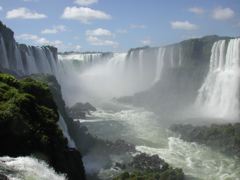 Our first stop in Brasil was to visit the awe-inspring waterfalls of Iguassu, or "Yguazu" in the
Our first stop in Brasil was to visit the awe-inspring waterfalls of Iguassu, or "Yguazu" in the original Guaraní, meaning "big water." Both Bee and I have been there before (separately), but you could see them a thousand and one times without ever being less than thrilled.
original Guaraní, meaning "big water." Both Bee and I have been there before (separately), but you could see them a thousand and one times without ever being less than thrilled.
Then we spent a couple of days touring the "green coast" between São Paulo and Rio. Perhaps the most significant experience we had there was our quest for ice. In order to put this story in context, I need to back up a second, and school y'all (as I have been schooled by a certain paraguaya) about the proper way to consume Ilex paraguayensis in the summertime.
First of all, the name for the the dried plant for drinking is "yerba." It is very healthful, as it is loaded with vitamins and minerals, as well as containing significant quantities of a stimulant in the caffeine family known as mateine. My unpublished data shows that 1.5 cups of strongly brewed coffee leads to perceptively shaking dissecting needles when viewed under 25x magnification, rendering ovarian dissection of fruit fly larvae all but impossible. Mateine consumed in enormous quantities has never led to the aforementioned shaking dissecting needles phenotype, and hence is highly recommended for daily consumption during graduate studies.
"Yerba maté" or "maté" is the preparation of yerba with hot water with which most are familiar (and that Argentinians, Brasilians and Uruguayans have erroneously led you to believe is the only real way to drink yerba). The yerba is placed inside of a vessel either shaped like or made out of a gourd (also, confusingly, called the 'maté'), and the steeped water is sucked through a straw like thingy (bombilla). One uses hot but not boiling water, and repeatedly pours over the same yerba as it goes from strong to weak (good for replenishing water, as yerba is a fairly strong diuretic).
 Maté is appropriate for consumption in cold weather, or in the early morning. However, contrary to the opinions of those neighboring Paraguay, the appropriate summertime-daytime preparation is tereré. The differences with maté are significant: (1) tereré uses ice cold water; (2) this cold water is kept in a thermos also containing a mixture of herbs ('remedios') of the drinker's choice - could include boldo, mint, lemon grass, arruda, avocado leaves, citrus leaves, and so on; (3) these fresh (not dried) herbs should be generally available in any neighborhood in any town (though people should be able to recognize these herbs as weeds etc., and can pick them oneself in most places); (4) the remedio sellers have a mortar and pestle for making the preparation of your choice- the going rate for remedios is about 20 cents; (5) the classic tereré vessel is a guampa, made from the base of the horn of a bull; wooden or metal ones shaped the same are widely-available vegan alternatives; (6) consume with a bombilla and repeated pours, as with mate; (7) enjoy! Drinking tereré is a way to beat the heat, to share time with friends and family, to take in healthful herbs, and to provide a mild stimulant. In other words, tereré is a way of life.
Maté is appropriate for consumption in cold weather, or in the early morning. However, contrary to the opinions of those neighboring Paraguay, the appropriate summertime-daytime preparation is tereré. The differences with maté are significant: (1) tereré uses ice cold water; (2) this cold water is kept in a thermos also containing a mixture of herbs ('remedios') of the drinker's choice - could include boldo, mint, lemon grass, arruda, avocado leaves, citrus leaves, and so on; (3) these fresh (not dried) herbs should be generally available in any neighborhood in any town (though people should be able to recognize these herbs as weeds etc., and can pick them oneself in most places); (4) the remedio sellers have a mortar and pestle for making the preparation of your choice- the going rate for remedios is about 20 cents; (5) the classic tereré vessel is a guampa, made from the base of the horn of a bull; wooden or metal ones shaped the same are widely-available vegan alternatives; (6) consume with a bombilla and repeated pours, as with mate; (7) enjoy! Drinking tereré is a way to beat the heat, to share time with friends and family, to take in healthful herbs, and to provide a mild stimulant. In other words, tereré is a way of life.
Argentinians scoff at tereré; but global warming will see the ascendancy of tereré - mark my words! Paraguay, where ice for your thermos is available literally everywhere (for example, our step-grandma downstairs in the Asunción house sells enough ice for tereré for about 10 cents), is way ahead of the game. Ice trays? Hah! Just take any of a wide range of used, empty containers ('disposable' plastic cups and washed out soymilk cartons work great), fill 'em with water, and put 'em in the freezer. Impress your friends by making randomly-sized ice cubes by bashing the sides of the soymilk cartons with your mortar.
These simple truisms of life in the tropics are apparently unknown to Brasilians. My portugese is not bad, but when I ask for ice (gelo), I get nothing but blank stares. When I finally am able to pantomime my desires, I am sent off on a golden fleece-like quest for the stuff. The freezer is broken in the market down the street, the restaurant won't part with any of its precious few (sissy) ice cubes, and the residents look at me like I just inquired about plutonium when I ask if anyone sells ice from their houses. When we finally found ice, it was in a supermarket - a 5kg bag. We were so desperate at this point that we actually thought it was a good idea to try to save some of this ice in our not-exactly-perfectly-sealable tupperware container. Upshot is that we got wet asses and some water damage to a few items in the backpack, including the Calvino book [sorry James- I'll get you a new copy].
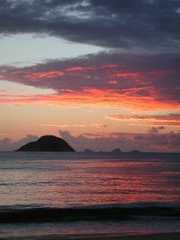 Having dried out our asses and possessions in the coastal sun & wind, our next stop was Niteroi, Rio's sister city, to visit Bee's friend Camila. If Seattle were Rio, Bellevue would be kind of like Niteroi: quieter, cleaner, over a bridge across the water. The two major differences, though, are: 1) Niteroi has very frequent ferry service to Rio; and 2) the water temperature is lovely.
Having dried out our asses and possessions in the coastal sun & wind, our next stop was Niteroi, Rio's sister city, to visit Bee's friend Camila. If Seattle were Rio, Bellevue would be kind of like Niteroi: quieter, cleaner, over a bridge across the water. The two major differences, though, are: 1) Niteroi has very frequent ferry service to Rio; and 2) the water temperature is lovely.  Can't do much about the cold water in the PNW (though all the SUV drivers on 520 every morning are apparently trying), but Bellevue has no excuse for their lack of ferry. Then there's also the open containers of beer, very little clothing, samba music on the streets, tropical fruit and a few other things a bit lacking in Bellevue. Niteroi has beaches that actually face west, so we looked for the green flash one night (didn't see it). Surrounding these beaches are some nice hills with pretty well-preserved trails into recovering Mata Atlantica habitat.
Can't do much about the cold water in the PNW (though all the SUV drivers on 520 every morning are apparently trying), but Bellevue has no excuse for their lack of ferry. Then there's also the open containers of beer, very little clothing, samba music on the streets, tropical fruit and a few other things a bit lacking in Bellevue. Niteroi has beaches that actually face west, so we looked for the green flash one night (didn't see it). Surrounding these beaches are some nice hills with pretty well-preserved trails into recovering Mata Atlantica habitat.
Rio was gearing up for carnaval in the time we were there. The streets of the Botafogo and Lapa neighborhoods were lively with rehearsals and a generally festive atmosphere. Lapa also has some great samba clubs, where we saw a neighborhood 'bloco' rehearsing their tunes one night, and, on another, a small-group samba band at the famous Carioca de Gema club. The music literally did not stop for hours (i.e. all the songs segue into the next). The pandeireiro's fingers were blisteringly fast, and the singer that night was fantastic. I later found out that he's one of the most sought-after samba singers for 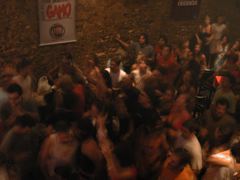 carnaval blocos. This is not only because of his great voice and stylings, but also his stamina: blocos each play their one signature song over and over again for hours on end.
carnaval blocos. This is not only because of his great voice and stylings, but also his stamina: blocos each play their one signature song over and over again for hours on end.
Then we headed up the coast to the afro-brasilian state of Bahia. Camila's mom lives in a beautiful house in Araial d'Ajuda, a short ferry ride from the famous tourist town of Porto Seguro. It had been 8 years since I last tasted acarajé, the bahian delicacy made of mashed black eyed peas deep fried in palm oil (dende), then split open and filled with your choice of a pico de gallo-like salad, vatapa (a fish cream sauce) and/or shrimp. Oh, and don't forget the hot sauce! It is kickin!! "Quente" (lit: "warm") means spicy in the language of acarajé. Bee & I ordered ours 'bem quente' and got nice cold beers at the barraca next store (Paraguay & Brasil both are very conscious of having their beers served just above the freezing point). In a word: livin'.
In Bahia, the water is warmer, and north of Porto Seguro, we hit low tide at a pretty amazing beach (Ponto de Barra Grande) where the reef intersperses with sand, and coral is visible in tide pools. 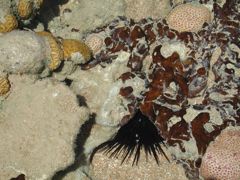 we were pleased to see many young corals, suggesting that this reef is in a recovery cycle. I also took a boat out to another low tide reef spot off the coast of Porto Seguro: the marine reserve of Recife de Fora. I wasn't really expecting this to be such a huge destination for Brasilian tourists. Four power boats (converted old sailing vessels) filled up with about 100 passengers each and headed out to the reef. On board, it's kind of a money making scam, where they rent masks, snorkels (fins aren't allowed on the reef), tennis shoes ('obligatory' footware according to the announcement), and heavily overpriced food & drink. Bahian music blares out of the distiorted speakers. I had my own snorkeling gear, water and food, and I wasn't about to wear no stinkin' tennis shoes, so I kept shifting my location on the boat, managing to avoid being noticed as not having the requisite footware. When we anchored, we were supposed to wait for this little motor boat to take us - 15 at a time - over to the sand bank on the reef. 400 people waiting 15 at a time to go 200 meters? Screw that. I jumped overboard and started exploring the reef on my own.
we were pleased to see many young corals, suggesting that this reef is in a recovery cycle. I also took a boat out to another low tide reef spot off the coast of Porto Seguro: the marine reserve of Recife de Fora. I wasn't really expecting this to be such a huge destination for Brasilian tourists. Four power boats (converted old sailing vessels) filled up with about 100 passengers each and headed out to the reef. On board, it's kind of a money making scam, where they rent masks, snorkels (fins aren't allowed on the reef), tennis shoes ('obligatory' footware according to the announcement), and heavily overpriced food & drink. Bahian music blares out of the distiorted speakers. I had my own snorkeling gear, water and food, and I wasn't about to wear no stinkin' tennis shoes, so I kept shifting my location on the boat, managing to avoid being noticed as not having the requisite footware. When we anchored, we were supposed to wait for this little motor boat to take us - 15 at a time - over to the sand bank on the reef. 400 people waiting 15 at a time to go 200 meters? Screw that. I jumped overboard and started exploring the reef on my own.
The part of the reef nearest where the boats anchor was not in the greatest condition. This may be related to the fact that one of the boat operators (not ours) had anchored on the reef instead of the adjacent sand. Going a little more distant from the boats, I started seeing some more live coral, including sea fans and some reef forming coral as well. Mostly small fish. One sea star and one sea urchin species. Then I decided to swim over and check out the 100 meter wide tide pool that all the tourists go to. Most people wander into the sandy-bottomed pool only for about 20 meters, and the water is so murky on that side, with the kicked up sediment, that you can't see much. Plus, if you don't know how to choose the right mask (those on board didn't help with this), it will probably leak, making snorkeling less than enjoyable. Thus, few ended up snorkeling to the other side of the tide pool, where the conditions were much better: a lot more live coral, obviously, some big groupers and other fish, and some wicked tube worms. I encountered a massive brain coral individual endemic to the Bahian coast. The habitat volunteers all laughed when they saw me emerge in bare feet - turns out they are all barefoot too; just the tourists are supposed to wear the overpriced rental sneakers. The volunteer guides also gave some good talks on habitat preservation, pointing out that 97% of the reef is off limits, and is hence in much better shape than the parts the tourists trample (he didn't mention the heaps of suntan lotion, soaps, and other body products that must accumulate in that pool every day). One of the guides had hands fast enough to dig out the ass end of a sea cucumber (something about which I am a bit of an expert) that he spotted based upon its signature hole in the sand.
One day, Bee, Camila and I headed south to the little, charming beach town of Trancoso. At sunset, the plaza had the standard set up for a NE Brasilian town center: pedestrian zone, acarajé bubbling, hand made jewelery and assorted goods for sale, and row upon row of caipirinha makers. By the way, the only real way to make a caipirinha (as all of these caipirinha makers know well) is to use a mortar to crush the limes along with the sugar in the bottom half of a cocktail mixer; then add the cane sugar booze (cachaça; a lot), pour it all over ice (including the lime pieces), and serve. In Trancoso, we got one of these gems with a twist: substitute passion fruit juice (maracuja, or 'mburucuya' in the original Guaraní) for half of the limes. Heavenly. There was also a treat going on in Trancoso that night: a roda of absolutely masterful capoeiristas from the local Sol de Bahia school. Wow. Fast doesn't begin to describe their talent.
 With a fair bit of saudade (untranslatable word meaning something like longing), we left the lovely Bahian coast behind for the long journey back to Paraguay, but with one last stop before hitting the road: the vege market in Arraial d'Ajuda to get some fruit for the road, and, of course, to replenish our hot sauce supply (e por matar saudade).
With a fair bit of saudade (untranslatable word meaning something like longing), we left the lovely Bahian coast behind for the long journey back to Paraguay, but with one last stop before hitting the road: the vege market in Arraial d'Ajuda to get some fruit for the road, and, of course, to replenish our hot sauce supply (e por matar saudade).
The bus trip south turned out a bit more eventful than we had bargained for. Two hours into the trip, the automatic door in the front of the bus started to malfunction. After an hour working on this problem, they had jury rigged a fairly sketchy looking solution, and the passengers were skeptical. The general consensus was that this would be a continuing problem (perhaps even a serious risk in an emergency), so we should lobby for a new bus. In the meantime, an empty bus from the same company had pulled up alongside. The bus company staff originally resisted making the switch, until one of the passengers took out his digital camera to snap a picture of the aforementioned sketchy-looking door mechanism (wires and screws were all hanging out, wrapped in sloppy looking tape). Then the decision was made: we would switch buses. The peoples voice was heard, and there was much rejoicing....
....until a couple hours later, when the new bus ground to a halt in the middle of the night in some small town. The driver managed to get the bus started, and was able to get us about 15 km further down the road, until we were truly in the middle of who-knows-where. Then the engine totally died.
The sun was just coming up, so gradually the groggy passengers started getting off the bus to find out where we were and what the problem was. Whoops! No motor oil! It wasn't a leak either. They musta just sorta forgot to fill it up again after the last oil change.
We happen to have ended up stranded in the detour part of the route, on a dirt road; a section of the N-S highway had been washed out by recent storms. The local residents were just getting up, and many curious onlookers gathered around to see what was up. We were tired and hungry (on long distance Brasilian bus trips, you get used to and plan for the frequent food stops en route).  The lady in the front row who had passed out Jesus cards to everyone on the bus was continually asking O Senhor not to forsake his children. Roosters crowed. A few kind local residents offered coffee and mangos, which were consumed with much gusto. The sun rose higher, and we crowded in the shade. After many hours, a company mechanic arrived with extra motor oil, filled er up, got er started, and we were back on our way. The town residents waved goodbye as we continued to wonder where the heck we were. The lady in the front row was, of course, vindicated.
The lady in the front row who had passed out Jesus cards to everyone on the bus was continually asking O Senhor not to forsake his children. Roosters crowed. A few kind local residents offered coffee and mangos, which were consumed with much gusto. The sun rose higher, and we crowded in the shade. After many hours, a company mechanic arrived with extra motor oil, filled er up, got er started, and we were back on our way. The town residents waved goodbye as we continued to wonder where the heck we were. The lady in the front row was, of course, vindicated.
Mangos... Did I say something about mangos? That's our exciting concluding chapter...
Peace
bug
p.s. A few of you have disputed my description in chapter 1 of 'making love hanging upside down without using your hands' as something that is probably not worth trying. Fair enough, but until I receive an analysis by someone having actually conducted the experiment, my original comment stands.
Posted: January 31, 2008
 The drivers are quite a sight to behold. This ain't Seattle, where bus drivers wait patiently until all passengers have paid and at least grab a hand-hold before proceeding. Not only do the Asunción drivers take your fare and make change for you while en route (the drivers must have been seriously pissed when they raised the fares from 2000 Guaraní to 2200 recently), but they generally don't even wait for you to get on the bus before starting on their way. Also, note that these buses all have manual transmissions, so they are changing gears, counting and passing change, tearing off the generally superfluous tickets and turning the wheel, all simultaneously. Quite a juggling act. Disembarking, too, requires good passenger timing, since the bus never really seems to come to a complete stop. They do slow down for you, though. Usually.
The drivers are quite a sight to behold. This ain't Seattle, where bus drivers wait patiently until all passengers have paid and at least grab a hand-hold before proceeding. Not only do the Asunción drivers take your fare and make change for you while en route (the drivers must have been seriously pissed when they raised the fares from 2000 Guaraní to 2200 recently), but they generally don't even wait for you to get on the bus before starting on their way. Also, note that these buses all have manual transmissions, so they are changing gears, counting and passing change, tearing off the generally superfluous tickets and turning the wheel, all simultaneously. Quite a juggling act. Disembarking, too, requires good passenger timing, since the bus never really seems to come to a complete stop. They do slow down for you, though. Usually.







